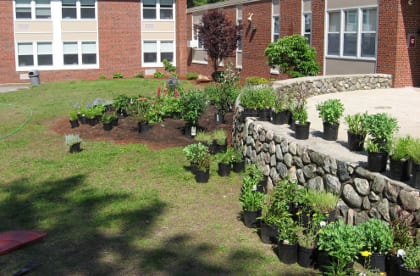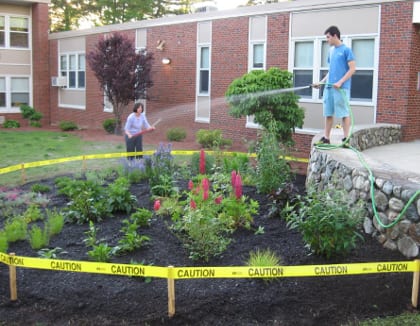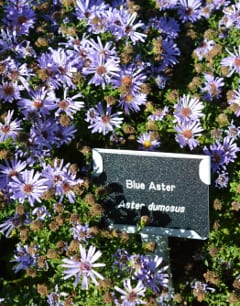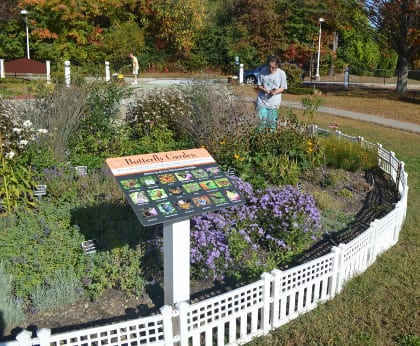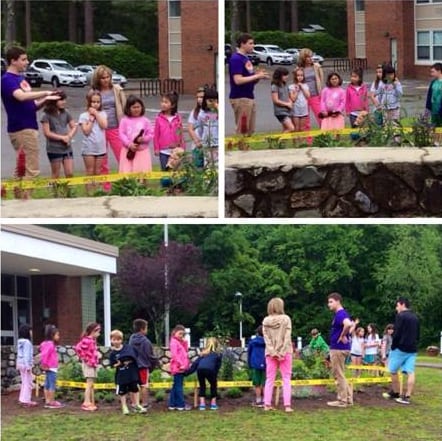A former student’s Eagle Scout project provides students a place to learn about butterfly and pollinator conservation.
by Bruce Wenning
Boy Scout, Sam Gantert (17) of Westwood, MA had an idea that developed a while ago when he was a student at the Martha Jones Elementary School in his home town. At that time Sam participated in his school’s butterfly program, and he became fascinated about the biology and habitat requirements of these colorful and gentile insects. It’s well known to parents and teachers alike that young children are curious about the natural world around them, and in particular, insects. Many young children interact with various kinds of insects while playing at home and school.
Sam had his sights set on developing an Eagle Scout project that encompassed his early interest in butterflies and his newly acquired interest in the host plants that sustain these insects. Hence, his conservation ethic was born! First, he needed to research the plant species that are best at attracting these insects into an aesthetically pleasing garden that satisfies both butterflies and people and, simultaneously, get the permission needed to carry out this project at Martha Jones.
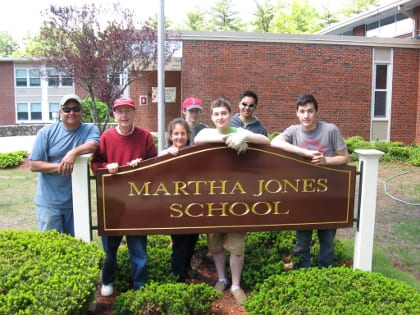
Sam Gantert (center) with a few of the volunteers who helped plant a butterfly garden at Martha Jones School.
Under the direction of Richard de-Reyna, scout master, and Louis Marten, Unit Committee Chair and Sam’s Eagle Scout mentor, Sam put forward his proposal and got permission for the project from the school’s principal, Mrs. Donna Tobin in 2014. Once the project and site were secured, the project specifics were left up to Sam to research, organize, and implement.
Project Details
There were many steps in Sam’s planning and volunteer work process.
Step 1: First Sam got a copy of The Butterfly Book by Stokes and Williams. This book was a great resource, covering the larval and nectar food plants for butterflies, their life cycles and specific behaviors such as courtship, egg laying, puddling, and basking; photographs identifying the larval or caterpillar stage and corresponding adult stage of common species proved invaluable.
Step 2: For this project to be successful, Sam, using The Butterfly Book, paid special attention to selecting the plants needed for hardiness zone 6 (eastern Massachusetts) that would attract and sustain native butterflies. After going through an exhaustive plant list of native and non-native butterfly plants, Sam did some internet research to narrow the list down to what was available at local plant nurseries. (see Table 1).
| Table 1. Martha Jones Elementary School Butterfly Plants |
| Family | Common Name | Latin name |
| Asteraceae | Yarrow | Achillea sp. |
| Asteraceae | Spike Gayfeather ‘Blazing Star’ | Liatris spicata |
| Asteraceae | Cone Flower ‘Pow Wow Wild Berry’ | Echinacea purpurea |
| Asteraceae | Shasta Daisy ‘Becky’ | Leucanthemum x superbum |
| Asteraceae | Shasta Daisy ‘Banana cream’ | Leucanthemum x superbum |
| Asteraceae | Black Eyed Susan ‘Goldstrum’ | Rudbeckia fulgida |
| Asteraceae | Joe Pye Weed ‘Chocolate Snakeroot’ | Eupatorium rugosum |
| Asteraceae | Small Globe Thistle | Echinops ritro |
| Asteraceae | Wood’s Light Blue Hardy Aster | Aster dumosus |
| Asteraceae | Threadleaf Corepsis | Coreopsis verticillata |
| Buddlejaceae | Butterfly Bush ‘Royal red’ | Buddleia davidii |
| Buddlejaceae | Black Knight Butterfly Bush | Buddleia davidii |
| Caryophyllaceae | Cheddar Pinks | Dianthus gratianopolitanus |
| Campanulaceae | Cardinal Flower | Lobelia cardinalis |
| Ericaceae | Highbush Blueberry | Vaccinium corymbosum |
| Fabaceae | Lupine ‘Gallery Red’ | Lupinus polyphyllus |
| Fabaceae | Lupinus ‘Russell Hybrid’ | Lupinus polyphyllus |
| Lamiaceae | Meadow Sage ‘Blue Hill’ | Salvia x sylvestris |
| Lamiaceae | Blue Mound Salvia ‘Blauhugel’ | Salvia x superba |
| Lamiaceae | Beebalm | Monarda didyma |
| Lamiaceae | Lavender ‘Fred Boutin’ | Lavandula angustifolia |
| Lamiaceae | Catmint | Nepeta x faassenii |
| Poaceae | Little Blue Stem | Schizachyrium scoparium |
| Ranunculaceae | Columbine | Aquilegia caerulea |
From this list, Sam designed on paper which plants would be aesthetically pleasing to the eye and serve as good butterfly plants. Sam focused on plant texture and color, form, height at maturity, spacing, bloom times, and care.
Step 3: Once Sam settled on which plants were available from selected local nurseries he ventured out to ask these plant suppliers for plant donations. Not all could be accommodating. According to Sam, this process was the most time consuming part of the project. Lovell’s Nursery, Medfield, MA donated the majority of plants and Lowes, Dedham, MA donated gardening tools and work gloves. Lovell’s Nursery also gave Sam half off wholesale prices on some plants because the sales person was an Eagle Scout and had empathy for Sam’s efforts! Weston Nurseries, Hopkinton, MA had a few plants for sale that other nurseries did not. Typical of most Eagle Scout projects, support was a mix of plant and equipment donations and cash donations used to buy whatever else was needed. Several corporations and non-profits donated money directly to his project to help Sam buy additional plants and equipment. Ultimately, donations covered all material costs (see Table 2).
| Table 2. Cost of Project Materials and Donor Amounts |
| Type of Material | Cost of Material |
| Butterfly Bushes | $125.40 |
| Perennial Flowers | $866.89 |
| Manure | $44.00 |
| Trowel/Shovel | $13.00 |
| Buckets | $8.00 |
| Tarp | $7.00 |
| Hose Nozzle | $8.00 |
| Hose | $24.00 |
| Extra Work Gloves | $3.00 |
| Stakes | $10.56 |
| Butterfly Color Kiosk | $224.01 |
| Botanical Display Labels | $266.40 |
| Fencing | $189.98 |
| Leaf Mold Mulch | $170.00 |
| Total | $1,960.24 |
| Donor | Amount |
| Martha Jones PTO | $900.00 |
| Martha Jones Principal Fund | $300.00 |
| Norwood Bank | $250.00 |
| Dedham Savings Bank | $100.00 |
| Rotary Club | $100.00 |
| Needham Bank | $100.00 |
| Personal Donation | $250.00 |
| Total | $2,000.00 |
Sam stressed that he had to do a lot of asking and continue to seek out the right butterfly plants to make the project work correctly as a sustainable conservation project.
Step 4: Sam organized willing friends and family into a cohesive volunteer group to help with the butterfly garden preparation. The garden had become neglected over the years, and the principal welcomed Sam’s project. Preparation involved removing the sparse amount of shrubs and ornamental grasses and transplanting them to other school garden beds, raking off all woodchip mulch, and removing the weed barrier textile fabric covering the bare soil. Once this was done, Sam and his volunteers added composted cow manure to the garden and turned it over with shovels incorporating the manure into the soil. They used rakes to re-grade the soil surface. Now the area was nutrient rich and ready for butterfly plant placement and planting.
Step 5: On the following weekend, Sam and volunteers transported all plants to the site. Sam placed plants in position, and he and the volunteers planted them according to Sam’s planting plan. Sam directed the volunteers, many of whom were “plant challenged,” to refer to the photographs on the pot labels if they needed help identifying the right plant for a particular spot. Sam said that it helped for the volunteers to know this information before attempting to plant and led to a smoother planting day.
Not all plants purchased or donated matched Sam’s design exactly in color and/or texture (as would be demanded by a professional designer); however, Sam’s overall design produced an aesthetically pleasing garden and ecologically functional one for butterflies and pollinators! His plant selection was more than adequate.
Once all plants were installed, Sam called David Vail, leaf mold supplier, who delivered the leaf mold to the site. Sam wanted leaf mold to serve as mulch instead of wood chips. Leaf mold is an excellent soil microbial substrate and breaks down quicker providing a more efficient source of nutrients. Volunteers helped Sam spread out the leaf mold carefully around each plant at a three inch depth.
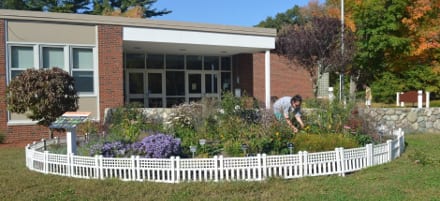
By September the garden has filled in. A fence installed around the garden keeps children and dogwalkers from getting too close.
Step 6: During the summer of 2014, and after all plants were installed, Sam and a few hardy volunteers monitored the garden on a weekly basis for weeds. Every few days they would water the garden to ensure plant establishment. The garden exposure was in full sun. Sam told me that weeding wasn’t as bad as he had anticipated probably because the site had a very low amount of weed seed in the soil. He learned that watering on a two- to four-day interval during hot, dry weather was more important for plant establishment than weeding.
By late August to early September, the plants that were planted in late May were much larger, filling in the bare spots quite effectively. Extra money was spent for professional plant labels and a kiosk displaying photos of common butterflies; both were great additions that the school wholeheartedly welcomed. Now novices can identify the plants and associated butterflies without the aid of a staff naturalist.
It’s More than Just A Pretty Garden
As part of his project, Sam incorporated a butterfly/pollinator conservation education plan for the school. He lectured to the second grade class on the importance of butterfly and pollinating insect conservation to the local ecology. His outside lecture/demonstration program was critical to aiding the teacher’s science programs about ecology and the conservation of these beneficial insects. Sam said that the kids were amazed at the sight of flower-visiting insects and asked a lot of intriguing questions. What a great learning experience for all! The school now has a “hands on” butterfly garden that is used by the science class to teach youngsters about certain aspects of plant-insect ecology. The teachers see the value in this and hopefully, these young minds will develop a conservation ethic as they grow into adulthood. It’s this kind of outdoor education that sparks their interest.
Sam also stated that the butterfly plants attracted more non-butterfly insects than what he had expected. These other insects are pollinators and pollen feeders. All insects shared the garden with a few hummingbirds too, which increased the human visitation factor. The butterfly garden also stimulated a math teacher to use it to demonstrate how to measure non-rectangular shapes.
A Learning Experience for All Involved
Earning the Eagle Scout badge is a demanding process that requires balancing the demands of school and a possible part-time job in addition to everything else life has to offer teens. Sam learned many other things about himself and others during this process.
He repeated to me that considering the entire process, it was personally approaching potential donors for plants and materials that proved to be the most time consuming. During the garden installation, organizing garden volunteers into specific work groups that did not encroach on one another was the greatest “on site” challenge, but installation was the most satisfying step. At this stage, Sam could see that his plan coming to fruition: development of an ecologically functioning butterfly garden with an accompanying demonstration/lecture program to educate young minds about the importance of butterflies to the local ecology.
School personnel and the scout authorities gave Sam complete creative and scientific freedom to carry out the entire project. He learned how forgiving and supportive adults can be during the process. The adults trusted his decision-making skills, and he did not want to let the adults down. For Sam, the entire Eagle Scout project combined learning new things (butterflies and their host plants) while participating in a personal maturation process (organizing and working with volunteers of all ages and meeting deadlines).
He also learned that his personal skills of conflict resolution, multi-level tasking, and cooperation with others and his creative design talent were all focused more effectively during the short timeframe of the Eagle Scout project than during any other single event of his high school experience.
Sam said that his research, design, and project completion all had unexpected variables that he learned from and adapted to. He learned how to meet critical deadlines imposed by the Eagle Scout plan. Having been involved with twelve Eagle Scout projects while working at Mass Audubon, I know from experience that deadlines imposed on these projects drive their efficiency.
How did Sam feel after completing his project? He recognizes his project as a valuable and creative learning experience. His concern now that the butterfly garden is completed is that the product of his efforts and the efforts of volunteers not be neglected. He has continued to maintain the garden beyond the project requirements, and his effort has been recognized by the school staff. The school is developing a committee of parents who will take over the maintenance of the garden when Sam heads to college in Fall 2015.
Author’s note: Sam Gantert (Troop 3, Westwood, MA) was awarded his Eagle Scout Badge on April 23, 2015. He will graduate from Westwood High School this June and attend the University of Saint Andrews in Scotland in the fall. His course of study will be International Relations. I have been friends with his mother, Ivy, since 1983 when we were students at UMass/Amherst, and I was a volunteer for this project.
About the author
Bruce Wenning is a horticulturist at The Country Club in Brookline, MA, and is on the ELA Board of Directors.
Helpful books on butterfly and pollinator gardening
Stokes, D., Lillian Stokes and Ernest Williams. 1991. The Butterfly Book. An easy guide to butterfly gardening, identification, and behavior. Little, Brown and Company, Boston. 95p.
Shepherd, M., S. L. Buchmann, M. Vaughan and S.H. Black. 2003. Pollinator Conservation Handbook. The Xerces Society, Portland, Oregon. 145p.
Holm, Heather. 2014. Pollinators of Native Plants. Attract, observe and identify pollinators and beneficial insects with native plants. Pollination Press, LLC. Minnesota. 306p.
Leaf Mold Supplier
David Vail at 978-656-9996 (Office); 617-594-7377 (Cell).
Helpful websites
www.pollinator.org
www.xerces.org
www.scouting.org

